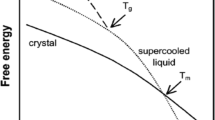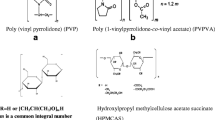Abstract
Purpose. To measure the molecular mobility of amorphous pharmaceutical solids below their glass transition temperatures (Tg), using indomethacin, poly (vinyl pyrrolidone) (PVP) and sucrose as model compounds.
Methods. Differential scanning calorimetry (DSC) was used to measure enthalpic relaxation of the amorphous samples after storage at temperatures 16-47 K below Tg for various time periods. The measured enthalpy changes were used to calculate molecular relaxation time parameters. Analogous changes in specimen dimensions were measured for PVP films using thermomechanical analysis.
Results. For all the model materials it was necessary to cool to at least 50 K below the experimental Tg before the molecular motions detected by DSC could be considered to be negligible over the lifetime of a typical pharmaceutical product. In each case the temperature dependence of the molecular motions below Tg was less than that typically reported above Tg and was rapidly changing.
Conclusions. In the temperature range studied the model amorphous solids were in a transition zone between regions of very high molecular mobility above Tg and very low molecular mobility much further below Tg. In general glassy pharmaceutical solids should be expected to experience significant molecular mobility at temperatures up to fifty degrees below their glass transition temperature.
Similar content being viewed by others
REFERENCES
A. Martin, J. Swarbrick and A. Cammarata. Physical Pharmacy. Lea and Febiger, Philadelphia, 1983.
M. Yoshioka, B. C. Hancock and G. Zografi. The crystallisation of indomethacin from the amorphous state below and above its glass transition temperature. J. Pharm. Sci. 83:1700–1705 (1994).
L.C.E. Struik. Physical aging in amorphous polymers and other materials. Elsevier Scientific Publishing Company, New York, 1978.
C. A. Oksanen. Molecular mobility in mixtures of absorbed water and poly(vinylpyrrolidone). PhD thesis, University of Wisconsin-Madison, 1992.
A. Saleki-Gerhardt, C. Ahlneck and G. Zografi. Assessment of disorder in crystalline solids. Int. J. Pharm. 101:237–247 (1994).
J.-H. Guo. A theoretical and experimental study of additive effects of physical aging and antiplasticisation on the water permeability of polymer film coatings. J. Pharm. Sci. 83:447–449 (1994).
C. M. Sinko. An investigation into the relaxation behaviour of pharmaceutical film coatings. PhD thesis, University of Michigan, 1989.
C. T. Moynihan, A. J. Easteal, J. Wilder and J. Tucker. Dependence of glass transition temperature on heating and cooling rate. J. Phys. Chem. 78:2673–2677 (1974).
E. Fukuoka, M. Makita and Y. Nakamura. Glassy state of pharmaceuticals. 4: Studies on glassy pharmaceuticals by thermochemical analysis. Chem. Pharm. Bull. 37:2782–2785 (1989).
S. Montserrat. Physical aging studies in epoxy resins. 1. Kinetics of the enthalpy relaxation process in a fully cured epoxy resin. J. Polym. Sci. (Polym. Phys. Ed.). 32:509–522 (1994).
G. Williams and D. C. Watts. Non-symmetrical dielectric relaxation behaviour arising from a simple empirical decay function. Trans. Faraday. Soc. 66:80–85 (1970).
I. M. Hodge. Adams-Gibbs formulation of non-linear enthalpy relaxation. Mat. Res. Soc. Symp. Proc. 215:11–22 (1991).
J. M. G. Cowie and R. Ferguson. Physical ageing of poly(methylmethacrylate) from enthalpy relaxation measurements. Polymer. 34:2135–2141 (1993).
C. M. Roland and K. L. Ngai. Normalisation of the temperature dependence of segmental relaxation times. Macromolecules. 25:5765–5768 (1992).
C. A. Angell, C. Alba, A. Arzimangolou, R. Bohmer, J. Fan, Q. Lu, E. Sanchez, H. Senarati and M. Tatsumisago. Slow processes in viscous liquids: stress and structural relaxation, chemical reaction freezing, crystal nucleation and microemulsion arrest, in relation to liquid fragility. AIP Conference proceedings (Slow Dyn. Condens. Matter). 256:3–19 (1992).
L. Slade and H. Levine. Glass transitions and water-food structure interactions. In J. E. Kinsella (eds.), Advances in food and nutrition research, 38, Academic Press, San Diego, 1993.
A. J. Barlow, J. Lamb and A. J. Matheson. Viscous behaviour of supercooled liquids. Proc. Roy. Soc., London. Series A. 292: 322–342 (1966).
W. Kauzmann. The nature of the glassy state and the behaviour of liquids at low temperatures. Chem. Rev. 43:219–256 (1948).
J. H. Gibbs and E. A. DiMarzio. Nature of the glass transition and the glassy state. J. Chem. Phys. 28:373–383 (1958).
C. A. Angell, L. Monnerie and L. M. Torell. Strong and fragile behaviour in liquid polymers. Mat. Res. Soc. Symp. Proc. 215: 3–9 (1991).
C. A. Angell, R. D. Bressel, J. L. Green, H. Kanno, M. Oguni and E. J. Sare. Liquid fragility and the glass transition in water and aqueous solutions. J. Food Eng. 22:115–142 (1994).
R. Bohmer, K. L. Nagai, C. A. Angell and D. J. Plazek. Nonexponential relaxations in strong and fragile glass formers. J. Chem. Phys. 90:4201–4209 (1993).
M. L. Williams, R. F. Landel and J. D. Ferry. The temperature dependence of relaxation mechanisms in amorphous polymers and other glass-forming liquids. J. Am. Chem. Soc. 77:3701–3707 (1955).
M. Cutroni, P. Migliardo, A. Piccolo and C. Alba-Simionesco. The dynamic glass transition of a ‘fragile’ molecular liquid in the megahertz domain. J. Phys.: Cond. Matter. 6:5283–5293 (1994).
Author information
Authors and Affiliations
Rights and permissions
About this article
Cite this article
Hancock, B.C., Shamblin, S.L. & Zografi, G. Molecular Mobility of Amorphous Pharmaceutical Solids Below Their Glass Transition Temperatures. Pharm Res 12, 799–806 (1995). https://doi.org/10.1023/A:1016292416526
Issue Date:
DOI: https://doi.org/10.1023/A:1016292416526




